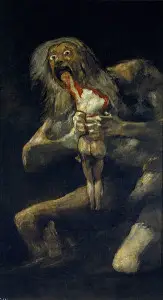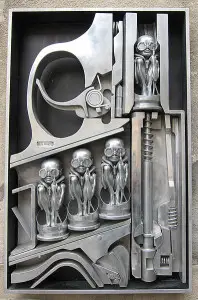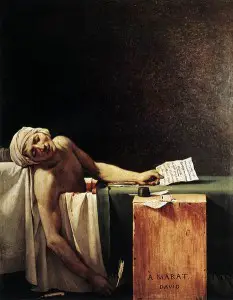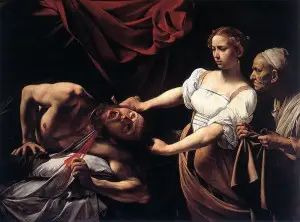Darkness is nothing except the absence of light, and evil is nothing else than an absence of virtue. A dark background provides an excellent contrast to project an object of interest in a painting. Similarly, an evil background projects a virtue in the meanings of a painting. Chiaroscuro is a technique in painting which uses strong contrasts of light and dark to project a vivid, three-dimensional effect to the whole composition. This technique was developed by Roger de Piles in France in the 14th century. The use of dark and light contrasts was also made in Tenebrism, a painting technique created by Michelangelo Caravaggio in Italy in the 17th century. Chiaroscuro uses more light than dark contrary to Tenebrism which uses more dark than light. Dark paintings use the light source and light colors against a dark background for apparent contrast. The subject matter, relating to some dark concept or a condition of ignorance, secrecy, gloom, tragedy, or a brutal concept may categorize a painting as a dark painting.
1. ‘The Temptation and Fall of Eve’

‘The Temptation and Fall of Eve’ is a pen-and-watercolor illustration by William Blake, the illustrious poet and painter of his time. His illustrations of Milton’s Paradise Regained were probably inspired by Milton in his childhood as he wrote in a letter on September 12, 1900 to John Flaxman, ‘Milton loved me in childhood and shewed me his face.’ The composition of his pen-and-ink drawing shows the prohibited fruit appearing on the tree in the form of full, ripe, colorful, juicy fruits ready to fall like a shower or the drops of a fountain. Influenced by Satan, Eve had taken the fruit into her mouth while Adam is still facing in the opposite direction trying to evade. William Blake lived from 1757 to 1827. His pencil sketch ‘Eve Tempted by the Serpent’ is preserved in the Victoria and Albert Museum in London.
2. ‘Hecate the Night of Enitharmon`s Joy’

William Blake’s usage of the dark and light contrast is best seen in his ‘Hecate The Night of Enitharmon`s Joy,’ wherein the black apparel in the foreground and the less dark background project the mid-ground object so prominently. It is an illustration in pen and watercolor on a 58 x 43 cm canvas. The painting, belonging to the symbolism genre, was completed in 1795. A scholastic interpretation of the Triple Hecate is, ‘She is triple, according to mythology, a girl and a boy hide their heads behind her back. Her left hand lies on a book of magic, her left foot is extended. She is attended by a thistle-eating ass, the mournful owl of false wisdom, and the head of a crocodile, blood-thirsty hypocrisy, and a cat-headed bat.’
3. ‘Green Lizards’

Alessandro Bavari was born in Latina, Italy in April, 1963. He was attracted towards photography since he was 15 years old. He studied scenography, photography, and many other disciplines related to painting. He is best known for his dark paintings. ‘Four Green Lizards Going to Suck Milk from a Young Mother’ is a representative painting of his art. It shows contrast achieved through the use of dark and light colors. Another aspect in which it is an unusual painting is that it shows a strong contrast between beauty and ugliness.
4. ‘Saturn Devouring His Son’

‘Saturn Devouring His Son’ is a dark painting by the Spanish artist Francisco Goya. It was not meant for public display; therefore, he painted it on a wall in his house. According to Greek mythology, the Father of gods, Saturn, devoured his own children to ensure that there was no one to ever be greater than himself. It is 1 of the 14 paintings he made on the walls of his home. The painting depicts that the child’s head and part of his left arm have been already been eaten while he is going to bite the other arm. Most of the painting is dark while the only lighter parts comprise the white flesh and red, blood-smeared body parts.
5. ‘The Great He-goat; Witches Sabbath’

‘The Great He-goat; Witches Sabbath’ is another of the 14 dark paintings of Goya. It is positioned just next to the horrible painting ‘Saturn Devouring His Son.’ Although the painting does not appear to be as horrible as other paintings, yet it is quite disturbing. It is considered one of the most important paintings of Goya. While the fresco was being transferred to canvas, it lost a minor part which gives it a strange feeling. Goya was born in 1746 in Fuendetodos, Spain and remained unrivaled in his field. He was a famous sketcher, oil painter, a fresco painter, and an engraver. This painting reminds us of the subject that Goya painted in the Lazaro Galdiano Museum in Madrid in 1798.
6. HR Giger’s ‘Birth Machine’

Hans Rudolf Giger’s painting ‘Birth Machine’ is strange illustration of an imagery of reproduction. The painting shows a revolver loaded with a strange, human offspring ready to be fired one by one. The transverse cut of the revolver shows the internal mechanism very clearly. Dark and light contrast is apparent, but the hidden contrast which is reveled to the viewer soon after looking at the painting for a few moments is that the reproduction is caused by the instrument known for destruction. The ‘Birth Machine’ is, in fact, a destruction machine, the revolver. Giger was part of the special effects team that won an Academy Award for visual effects in the movie Alien.
7. ‘The Death of Marat’

‘The Death of Marat’ is a dark painting by Jacques-Louis David showing the murdered revolutionary Jean-Paul Marat. It is considered one of the most important paintings of the French Revolution. It is an oil on canvas painting finished in 1793. The minimal background projects the object. Marat perceived the revolutionary like a Christian martyr. The painting shows the face and body of Marat immersed in soft, divine light. The painting is currently on display at the Royal Museum of Fine Arts in Brussels, Belgium.
8. ‘Judith Beheading Holofernes’

‘Judith Beheading Holofernes’ is a famous dark painting in oil by Caravaggio who was born in 1572 and died in 1610. The oil-on-canvas painting, measuring 145 x 195 cm is on display in the Galleria Nazionale d’Arte in Antica, Rome. The painting is about Judith, a rich and beautiful widow, for whom a whole book is devoted in the Bible. She symbolizes the power of Israeli people to defeat the enemy through the cunning use of courage. Judith enters into the enemy’s camp while the Israelis are being defeated. She cunningly entices the commander, and after intoxicating him with a cup of wine, beheads him. Caravaggio captured the moment of truth while Holofernes was still being beheaded with his eyes still open showing the extreme horror of the imminent and painful death.
9. ‘Heads Severed’

‘Heads Severed’ or ‘Heads of the Executed; Têtes des Suppliciés’ is a very disturbing, dark painting by the French artist Théodore Gericault. The painting shows two severed heads on a white cloth. The heads are considered coming from a guillotine. Another opinion is that it is a paint version of an illustration from the British surgeon John Bell’s book of anatomy Engravings, Explaining the Anatomy of the Bones, Muscles, and Joints. Gericault is best known for his painting ‘Raft of the Medusa,’ made after a series of paintings including: ‘Anatomical Pieces,’ ‘Head of a Drowned Man,’ and ‘Study of Truncated Limbs.’ The painting is preserved at the National Museum in Stockholm.
10. ‘The Nightmare’

Henry Fuseli is best known for his surrealistic painting, ‘The Nightmare.’ The painting shows a beautiful woman in her bed immersed in divine light with a devilish figure sitting on her chest. One can feel even the weight of the creepy creature which the sleeping woman might have been experiencing in her dream. The painting depicts an excellent contrast of light and dark as well as ugliness and beauty. The painting was so popular in Fuseli’s lifetime that he created a creepier version with an additional horse in the background and a sharper, weird creature sitting on her chest.
Conclusion:
A dark painting is to a romantic painting what evil is to good. Both exist in extreme contrast to one another, and each of them gives prominence to the other. Extreme contrasts sometimes look very unnatural; therefore, they need a little moderation. Rembrandt was aware of the impact of too sharp of contrasts; therefore, at times he deliberately diffused the objects to soften them and to make them more acceptable. Old masters created the effects of multiple light sources through imagery like the presence of angles to enlighten the whole ambiance.










Leave a Reply